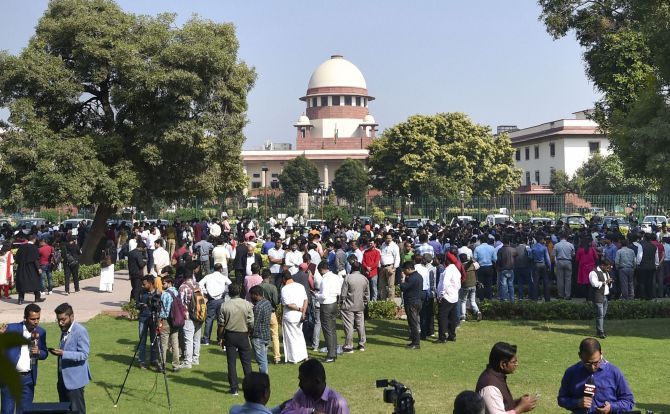 | « Back to article | Print this article |
The top court said there are serious infirmities in the oral accounts of Nirmohi witnesses that the disputed structure was not a mosque but the Janmabhoomi temple.

Nirmohi Akhara is not a Shebait, an authorised devotee, of deity Ram Lalla, the Supreme Court held on Saturday while dismissing its lawsuit in the Ram Janmabhoomi-Babri Masjid land dispute at Ayodhya.
The top court also said that the suit filed by the Akhara was time barred.
Nirmohi Akhara had claimed that it is the Shebait or devotee of the idol of Lord Ram installed in the Ram Janmabhoomi temple and has the exclusive right to repair and reconstruct the temple.
On December 17, 1959, it had instituted a suit through its 'Mahant' before the Civil Judge at Faizabad claiming that its 'absolute right' of managing the affairs of the Janmasthan and the temple had been impacted by the Magistrate's order of attachment and by the appointment of a receiver under Section 145.
Nirmohi Akhara is a Panchayati Math of the Ramanandi sect of Bairagis which is a religious denomination.
The Constitution bench headed by Chief justice Ranjan Gogoi, however, held that the oral testimony relied on by Nirmohi Akhara establishes that they were present in and around the disputed site.
'However, the presence of the Nirmohis around the disputed site does not amount to the exercise of management rights which entitle them in law to the status of a de facto shebait,' it said.
The top court said that shebait is the human 'ministrant and custodian' of the idol and acts as its authorised representative.
'The shebait is vested with the right to bring an action on behalf of the deity and bind it. In this view, the claim of Nirmohi Akhara that it is a de facto shebait on the basis of the oral and documentary evidence on record has been analysed and it has been found that the claim has not ripened into shebait rights,' it said.
The top court said there are serious infirmities in the oral accounts of Nirmohi witnesses that the disputed structure was not a mosque but the Janmabhoomi temple.
'The dedicated property legally vests in the idol in an ideal sense and not in the shebait. A shebait does not bring an action for the recovery of the property in a personal capacity but on behalf of the idol for the protection of the idol's dedicated property,' it said.
The documentary evidence relied on by Nirmohi Akhara does not establish its possession of the inner courtyard and the structure of the mosque within it, it added.
The top court said that contrary to the claims of Nirmohi Akhara, documentary evidence establishes the existence of the structure of the mosque between 1934 and 1949.
'A careful scrutiny of the documents which have been relied upon by Nirmohi Akhara does not lead to the inference that Nirmohi Akhara had exclusive possession of the disputed structure,' the bench said.
The top court said the course of events in the history of the communal conflict indicates a series of conflagrations between Hindus and Muslims in 1856-57 and 1934.
'The mosque was partially damaged in 1934 and subsequently, obstructions were placed in the course of offering namaz in the mosque involving a denial of the right to pray for the Muslims. This is followed by the events which took place on 22/23 December 1949 when idols were surreptitiously placed under the central dome,' the apex court said.
'Soon thereafter, proceedings were initiated under Section 145 resulting in the attachment of the property. In this background, it is difficult to accept the case of Nirmohi Akhara that the disputed structure was a temple which was in its exclusive possession and that no incident had taken place on 22/23 December 1949,' it said.
The Akhara had instituted the suit on December 17, 1959 through Mahant Jagat Das seeking a decree for the removal of the receiver from the management and charge of the Janmabhumi temple and for delivering it.
The claim of Nirmohi Akhara was is in respect of the inner courtyard, including the three domed structure of the mosque.
According to Nirmohi Akhara, the structure is a temple and not a mosque. The oral evidence which has been adduced to support this submission has been analysed earlier.
The SC, however, said: 'The oral evidence does not indicate any cogent, credible or trustworthy account of Nirmohi Akhara being in possession of the inner courtyard or structure.'
The court said that after the Magistrate's order dated December 29, 1949 for attachment of property, nothing prevented Nirmohi Akhara from filing a declaratory suit for possession and title.
The Magistrate‘s order did not decide or adjudicate upon the contesting rights to possess or the merits of conflicting claims of any of the parties, it said.
'The proceedings under Section 145 could not have resulted in any adjudication upon title or possession of the rightful owner as that is within the exclusive domain of civil courts.
'Nirmohi Akhara cannot take the defence that no final order had been passed in Section 145 proceedings and as a result limitation did not commence. The magistrate simply complied with the directions given by a civil court with respect to maintaining status quo in Suit 1 and accordingly, deferred the proceedings under Section 145,' it said.
The apex court said the period of limitation under Article 120 is six years and Nirmohi Akhara's claim was that the cause of action arose on January 5, 1950.
'The suit was instituted on December 17, 1959. Hence, the suit is outside the prescribed period of limitation and is barred,' it said.